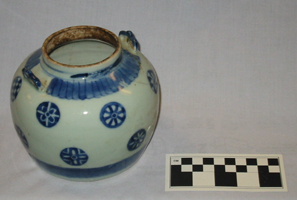The class for which this website was designed has come to a successful close! Following the link in the right hand column of this page, you can access the student papers written in this class. Two of these papers were read at the annual meeting of the Society for California Archaeology in Sacramento, as part of a panel presentation about this project. Members of the Chinese Historical and Cultural Project, Stanford University, and Past Forward, Inc. took part, and the panel was very well attended and stimulated considerable discussion afterward. It was great to see how much interest there is in the archaeological community concerning this collection! Now that the class has come to a close, this website will have new postings about once a month, although there may be more frequent postings if necessary. Please take advantage of the discussion tool located at the bottom of this page in order to be able to submit your own thoughts about this project or any of the content of this website! Because we are beginning a new phase of cataloging, this month’s posting is intended to provide some basic information about the work we are doing.
Several of the former students from the class will be cataloging this quarter. This is possible due to the financial support of the San Jose Redevelopment Agency – thank you! The cataloging phase of this project begins with the boxes pictured above right. These boxes contain artifacts sorted for the most part by material type. For now, we are concentrating on finishing the cataloging of all ceramics from this collection. As we identify and catalog the artifacts, they are then checked and entered into the database (see earlier postings for more detailed descriptions of these steps – they are available, organized by week, at the top of the right-hand column). After this, artifacts are individually repackaged and grouped according to the feature they were recovered from. The picture to the left shows the drawers in which these artifacts are stored. This allows us to have an overview of artifacts from the same feature, and the eventual repackaging and long-term curation of these artifacts according to feature will help facilitate interpretive research with this collection. We are looking forward to cataloging as much of this collection as possible, concentrating first upon completing the ceramics, and then moving on to glass artifacts.
Featured Artifact
One of the ceramic artifacts unpacked from the artifact boxes this past week was this teapot, artifact 85-31/18-1. This numbering system indicates that it is from the Market Street Chinatown, Lot 85-31. Specifically, it is from feature 18. The last number is a control number that assists in the inventory of artifacts from the same feature. This teapot is in remarkably good condition, although its spout has been broken off. Inside the teapot is the wire handle by which it would have been picked up. Although teapots such as these are characteristic for overseas Chinese sites, we have not been able to find out whether there is a name for the pattern of its decoration. Decorative patterns are often useful for determining the rough date of manufacture, place of origin, or relative economic value of an artifact. Do you know more about the decorative pattern of this teapot? If so, please let us know in the discussion comments! Please check back at this website. Even though we will be updating monthly, the discussion forum can be used to provide a place for discussion of this collection, project, and overseas Chinese archaeology. The discussion part of this website is yours!

